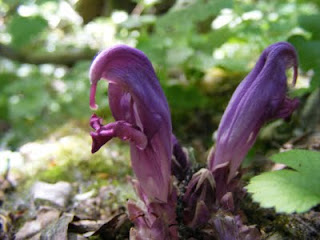 Easter Monday was warm and sunny; a great day for insects and flowers but too warm and bright for birds. By noon the reserve was pretty silent. The blackbird in the photo felt much the same as me; ready for a nap in the deck-chair. He was sunbathing and obviously enjoying it. Being covered in black feathers must be uncomfortable on a hot day, especially when you think about mites and feather-lice creeping about inside your duvet! Birds use a dust bath to treat their feathers, rather like wig powder. You may see a bird in a similar posture to this one, letting ants run all over it. They pick up ants and annoy them into squirting formic acid onto the feathers, which must be effective against parasites.
Easter Monday was warm and sunny; a great day for insects and flowers but too warm and bright for birds. By noon the reserve was pretty silent. The blackbird in the photo felt much the same as me; ready for a nap in the deck-chair. He was sunbathing and obviously enjoying it. Being covered in black feathers must be uncomfortable on a hot day, especially when you think about mites and feather-lice creeping about inside your duvet! Birds use a dust bath to treat their feathers, rather like wig powder. You may see a bird in a similar posture to this one, letting ants run all over it. They pick up ants and annoy them into squirting formic acid onto the feathers, which must be effective against parasites.Hot, still days like Monday are not ideal for birdwatching as sunbathing birds don't sing or fly about. Tuesday was a bit too cool, but we saw nightingales singing boldly in the open. However, today, Wednesday, was ideal; cool enough to encourage singing and sunny enough to give good views. The clear skies brought in a fresh wave of migrants too, including a very obliging male whinchat.

Wednesday is always a patrol day for the rangers. We have to pick up litter, check that the paths are safe and that everything is working as it should. For me this is an excuse to walk the estate, birding and botanising as I go. It's always a delight to meet happy customers too.
I particularly like to photograph plants as they don't move much, but they can still be really awkward when they want to. Blue toothwort is a native of Southern Europe that grows with a few struggling primroses on the site of a long-gone cottage among the debris of the quarry industry, in the middle of the densest thicket on the reserve. At least, it seemed that way, in fact, these plants are probably the result of a bit of fly-tipping in the '60s. I had to crawl a long way through briars and blackthorns on my hands and knees just to see if it was flowering yet. It is parasitic on the roots of willows and poplars so it doesn't need any sunlight. In fact it has no green parts so it can't photosynthesise.

I went on to check on another strange plant in another thicket, but this one is green all over and needs lots of sunlight. Adder's-tongue fern struggles to compete with fast growing, leafy shrubs and so it tends to grow in areas where the herbage is kept down by grazing, but its a fine line to walk; too much grazing in April and all the ferns get eaten. We have built special pen for this plant that excludes the rabbits at this time of year. The ferns are finished by June but the other plants keep right on going so we let the rabbits back in the pen to polish them off during the winter.
While patrolling, I enjoy seeing the fruits of all the work we did in winter to maintain the scrub and grassland. Each nightingale that returns re-assures us that we are doing something right. Of course, nightingales are the flagship species here at Paxton but garden warblers, whitethroats, lesser whitethroats, grasshopper warblers and turtle doves are all equally picky about the quality of the habitat they need.

The mixture of live and dead hedge-laying that we completed before the spring is showing signs of success as the living thorn bushes sprout and flower while the dead sections hopefully provide a scaffold for hops, brambles, ivy and bryony to colonise. The woven structure of the hedge provides secure nest sites for dunnocks, blackbirds and thrushes while the nettles beneath hide the shiny eggs of pheasants and mallards.
I walked the arable fields and the Great Meadow in search of flowers, but the dry weather is taking its toll there. I don't think our spring barley is going to do much except feed the rooks unless we get rain soon. The ditches were the only really interesting places to look for plants such as celery leaved buttercup, but even the ditches would be dry if it wasn't for our wind pump.
Next week is Nightingale week. We have a full programme of events including talks and walks which you can find out about on our website or in the Visitors' Centre. 'See you there.
